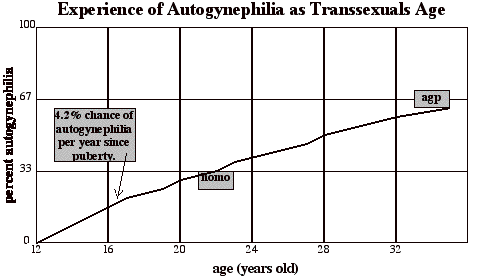
|
|

|
Does age or sexual orientation account for the different extent of cross-gender fantasies among transsexuals? It is surprising Blanchard did not covary age from his ANOVA because a previous theory distinguished primary and secondary transsexuality by age. I show that, assuming a fixed percent chance of a cross-gender fantasy per year, we can fully account for the differences between "homosexual" and "non-homosexual" transsexuals. Furthermore, the difference extent of cross-gender fantasies is likely an artifact of the design of the "Core Autogynephilia Scale."
This is page 10 of 13. [1] [2] [3] [4] [5] [6] [7] [8] [9] [10] [11] [12] [13]
Recall the sample question I mentioned earlier. Blanchard's measures of autogynephilia, consist of a series of yes/no questions that begin, "Have you ever..." "Yes" is always the answer that means more autogynephilic fantasies. Let's imagine any series of questions that begin this way. Ignoring ceiling and floor effects (and Blanchard's data is neither at floor nor ceiling), older people answering the questionnaire are bound to have higher scores than younger people simply because they have lived longer, have had more experiences in their life, and consequently more things to say "yes" to experiencing. This is an issue because Blanchard points out in this article that his group which scores lowest, those exclusively attracted to men, are also the youngest when they sought therapy. Perhaps the difference between the transsexual groups is simply an artifact of the way the questions are asked.
Let's further consider the possibility that age is what really underlies differences between the groups. Though Blanchard does not given exact age statistics for his sample, I infer that the 'homosexual' group is about 22yr and the other group is 34yr. For simplicity, let's change Blanchard's "number of yes" score to the more intuitive "proportion of yes" score and treat this either as the percentage of a transsexual with autogynephilia or alternately as the proportion of a individual transsexuals 'infected' with autogynephilia. The 'homosexual' group scores a 28% (s.d. 38%) and the 'non-homosexual' group scores a 68% (s.d. 36%). Let's assume both groups started to have sexual fantasies at puberty, around 13 years old. If age is what accounts for the difference then we could assume there is a fixed chance of having an autogynephilic fantasy each year. Naturally, as you get older you become more likely to have had an autogynephilic fantasy. In precise terms, you chances of having an autogynephilic fantasy this year are the chances you had of having it last year plus the fixed chance per year times the proportion of the population that still hasn't had the fantasy. Whew!! Okay, maybe it was hard to follow that one. Even worse is there are a few other little complications I finessed over (e.g., Blanchard sets up his questionnaire so that you can't give a "yes" to some questions if you gave a "no" to other questions). But I do not believe these issues substantially change the results. To make this more intuitive, let's look at a graph. It shows the percents of each group having had autogynephilic fantasies, plotted at their groups' age. It also shows a curve illustrating the increasing chance of having had this fantasy. In this case, I estimated that to fit Blanchard's data a transsexual has a 4.2% chance of having an autogynephilic fantasy each year. Said another way, a typical transsexual says "yes" to a bit less than one-third of a single question each year. Notice how close the empirical data in the graph match this theoretical function. Given this correspondence, it is unlikely Blanchard's result would remain significant if age were taken into account. It is also noteworthy that the chances of having an autogynephilic fantasy each year are remarkably low. The data do not match the clinical intuition that these fantasies are pervasive aspects of transsexuals' lives.

This is not the only reason Blanchard should have considered age. The classic description of transsexuality distinguishes two groups by age of onset: "primary" and "secondary." To challenge the older theory, Blanchard needs to demonstrate that his theory accounts for differences between transsexuals over and above differences that can be accounted for by the older theory. Though there are well known statistical procedures for addressing this concern (covary age from the ANOVA or enter age on a lower block in the regression), Blanchard did not do this. We do not know to what extent Blanchard's results are really due to sexual orientation because they may simply be due to age. The model presented in the graph suggests autogynephilia may be a relatively minor experience that transsexuals, provided they do not transition, become more likely to have as they get older.
This is page 10 of 13. [1] [2] [3] [4] [5] [6] [7] [8] [9] [10] [11] [12] [13]
|
|
|